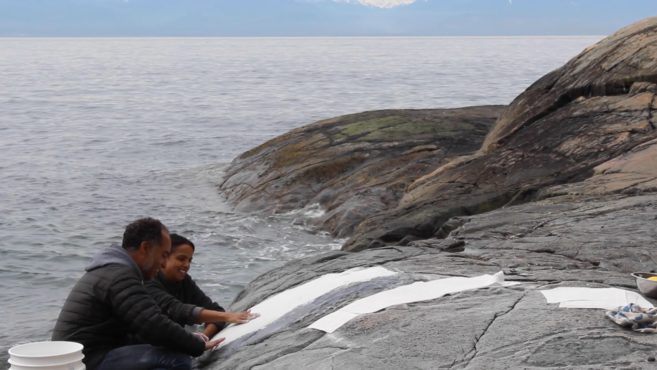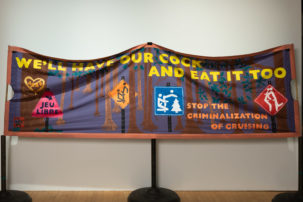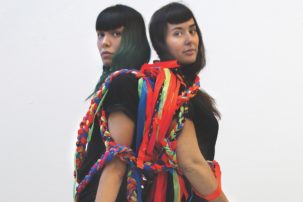Riel Bellow: I remember you telling me that you are rarely inspired, that instead the work is just always happening. It strikes me that your work isn’t aspirational. You don’t reach, you hold—the work is embodied. Your practice has a way of homing in on the space between an internal frequency and an external register, which is incredibly intimate. It insinuates a way of listening that is almost delicate; it is held with so much care. So, I wanted to start by asking: What is the importance of listening?
Kite: Listening is not a practice, but the practice of the unattainable. In that possibility of making anything—like new knowledge, where the act of listening becomes endless—you can only hope to hear something during each repetition of whatever it is you’re listening to. You only find the repetition through prolonged listening—it’s like having an extended ear and waiting for the pattern to show itself. Learning something new, listening to Elders, experiencing horrible things and experiencing really good things are some examples. All I can hope is that each time the repetitions happen, I’m able to listen and catch something important. It’s always good to have a community that reminds me to remember. We constantly go back to the source material, back to the people—you always have to go back and consult. That’s a cyclical thing, to be more than metaphorical, but maybe less than totally tangible. That’s what frequencies do: each sound oscillation is just a cyclical wave that comes and goes infinitely. Technically, if a sound goes out into the universe, it has the potential to go on forever. A light wave is the light cone.
RB: The light cone is the shape, or container, for the possibility of hearing.
K: I was thinking about time in a spiral. If it’s a two-dimensional spiral, it becomes a circle. You could collapse a spiral so tightly that it instead becomes a sphere. If you draw a line through that circle or if you cross through the light cone, you will hit all the points in history. You start to line up certain points and pass over them repeatedly, and then history starts to become the same. You might miss something the first time, so maybe you will be lucky enough to go around a second time or even an infinite number of times. The light cone is a mathematical model. In the realm of quantum theory, it is a model first proposed by the German mathematician Hermann Minkowski, who was a teacher of Albert Einstein. If a flash of light is sent out into the universe, the light cone becomes the shape of all of the points it could potentially ever reach. Theoretically, the path outward of that flash of light is infinite, but there is also an edge to the possible places it can travel. Returning to that tight circle, I think about the Lakota idea of the Kepemni, or Twisting Vortex. I made a piece called Everything I Say Is True (2017), in which it became useful to talk about science while using our perceptions about theoretical mathematics to manipulate what the audience could perceive as truth or evidence or facts, like those related to capital and knowledge.
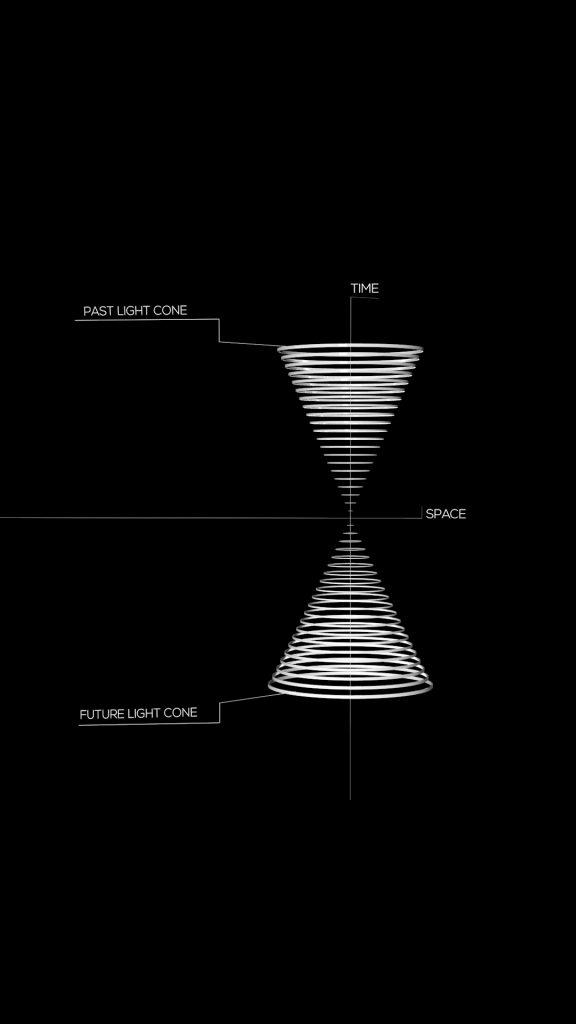 Kite, Pahá kiŋ lená wakháŋ (detail), 2017. Carbon fibre sculpture, sonar sensor, video and sound, dimensions variable.
Kite, Pahá kiŋ lená wakháŋ (detail), 2017. Carbon fibre sculpture, sonar sensor, video and sound, dimensions variable.
RB: I loved the trickster moves in Everything I Say Is True, which seemed to replace facts with possibility. The light cone is infinite, and yet there are boundaries to it. There are certain things—let me call them “cornerstones”—needed in order for reality to become grounded, a field we are able to live in. What constitutes a cornerstone of thought, or the snag that catches the repetition? Not necessarily a location, but maybe a qualitative experience?
K: That is definitely related to the idea of coming back over and over, a frequency that modulates in and out of audibility or experience- ability. That’s the big question: What defines reality? I have more of a desire to hear than a rootedness in listening—listening is aspirational. I hope that I can listen, but I have a desire to hear, which is more overwhelming, suffocating and loud, and maybe that’s the cornerstone of my psychological reality as an artist.
I listened to Leroy Little Bear speak at a conference recently. He said, “The anomaly is very important in Indigenous thought. For a very large extent, humans limit ourselves and our data intake to a state of awakeness. In the Native world, in our world, and a Blackfoot world and so on, the spectrum from which we take data is so much broader. So yes, dreams, for instance, are a basis of data intake because they are a real experience…. What I hear from animals, what I hear from Elders, and so on, most people would say those are just stories, those are just mythologies. There is the amount of spectrum we allow for.” In sum, humans are tuned in to only certain parts of the “radio dial,” as Little Bear has called it. Perhaps we have lost some technology for tuning in.
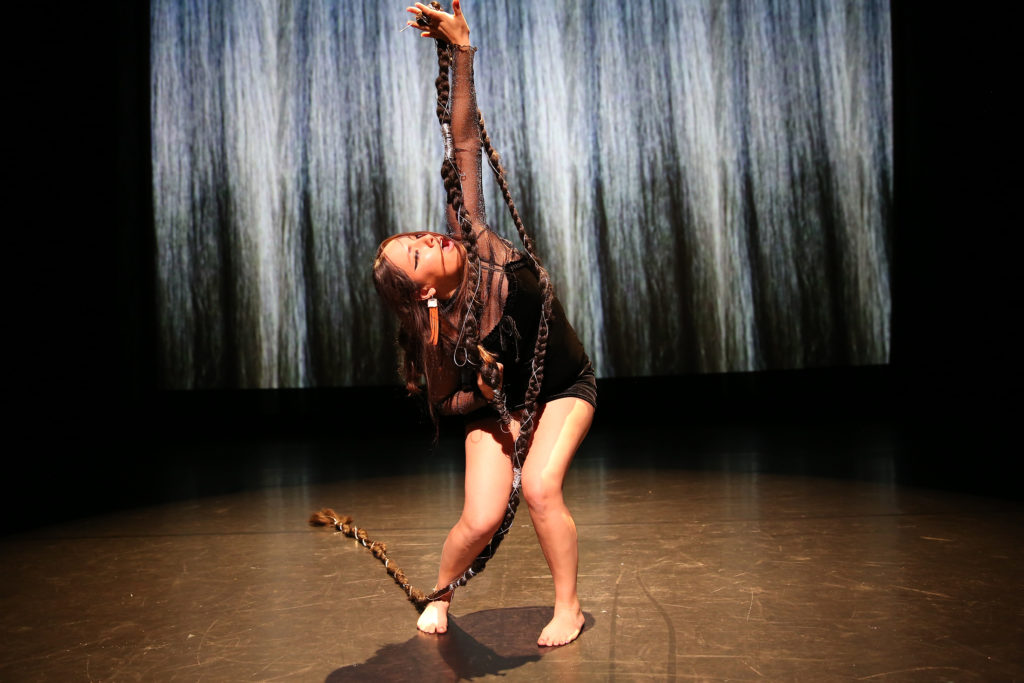
Kite, Pȟehíŋ kiŋ líla akhíšoke. (Her hair was heavy.), 2019. Performance, sonic sculpture and processor. 8 min. Photo: Steve Gunther.

Kite, Pȟehíŋ kiŋ líla akhíšoke. (Her hair was heavy.), 2019. Performance, sonic sculpture and processor. 8 min. Photo: Steve Gunther.
The more spiralled the form becomes, the more clarity is available, and the more the repetition in the pattern can emerge. Time becomes tighter in that moment.
RB: Lost technologies and technologies not yet made. You are a wizard of creating technologies; that seems so central to what you do. The first time I ever encountered your work, I remembered hearing that you built a computer the year before, and I wondered, “Who is this genius in front of me?”
K: [laughs] Yes, I built that computer. My artwork is an attempt to build tools and skills, to use technology to tune in to those frequencies. For example, different Indigenous philosophies, linguistics, practices or ceremonies, those are all the technologies we have or had or will have in the future to tune in to certain frequencies (thinking about past, present and future, as the artist Scott Benesiinaabandan does). Those technologies would help me exit the light cone or cut through to the different levels of the time spiral.
RB: Let’s knit frequencies. Tell me about your own favourite technologies.
K: My most successful technology has been getting myself into a listening state through form. In Listener (2018), for example, I’m reciting poetry while moving a hair-braid interface that is part of a machine-learning system. The setup of the computational system gets me into the state of spiralled listening. In the performance, I’m speech-jamming myself by talking out loud while being recorded, and that recording is shuffled every 10 seconds. I can only hear the shuffled part; I can’t hear myself speak. The feeling of hearing yourself on a 10-second delay and out of order while trying to continue to speak is overwhelming. Those recordings are layered into a spiral form. The more spiralled the form becomes, the more clarity is available, and the more the repetition in the pattern can emerge. Time becomes tighter in that moment, but that’s only set up out of my own desire to reach a listening state that is not available to me in normal life experience. It’s only attainable in a dissociative state.
RB: You recently put out an album called People You Must Look at Me (2020) on your record label, Unheard Records.
K: That piece comes out of a process of composing where I want to set up a listening system and a form to explore during performance, and perhaps to explore ethically. For the album’s compositional system, I set up a chiastic structure where you have an event in the middle of that which is cocooned. The event in the centre is the experience of a death, because death is eternal. I mean, you might come back, but your body’s death is eternal. It goes into the earth and that’s that. We’re not like plants. We don’t get to come back every spring.
In my recording sessions, I always use skilled musical improvisers, whom I record separately, giving them a backing track to perform to and provide the form. Then I arrange their improvisations onto that form. I’m able to leave room for their improvisational genius, because they’re all geniuses at what they do. I’m also able to show that, when things line up, the magic happens in spiral time. Perhaps this is due to the form, but it feels like magic. Then when I perform with, on top of or in between that structure, I’m able to interface with that magic through my electronic hair braid.
I have new compositions now, which I’m making in textiles. These cloths come out of a practice I wanted to do with making prayer cloths, so you can keep a stitched prayer on a handkerchief in your pocket and carry it with you so you can touch it and perform it.
RB: I took a math class in college and the first thing the teacher said was, “Numbers and letters are both symbols for sound.” The teacher insinuated that numbers are the organizing principle of the universe, and that the whole manifested world is born through different sounds and frequencies. Variations of form are mediated through frequency, back and forth and open. Creation stuff—we live in song. I am hearing the stitched prayer on a handkerchief work in a similar way; the pattern of the stitches has a birthing quality, not reproductively but rather through a kind of mimesis, with a gap. This feels related to the piece you just made for the Tulsa Artist Fellowship.
K: That piece is called Wichahpih’a (a clear night with a star-filled sky or a starlit night) (2020), and it is made of silver thread on blue satin. I created it by using an embroidery machine called the Tajima, which has the capacity to lay conductive thread. The shapes are based on the tradition of Lakota women’s geometry, which is an infinite semiotic language where the symbols can grow out of each other continuously. My understanding is that the symbols are meant to take a dream or vision and translate it through the semiotics into a legible story. I don’t think I fully understand what this pattern I have created means to me yet. I know that I want it to be touchable by a musician, read with their fingers and then performed. It is meant to be sounded.
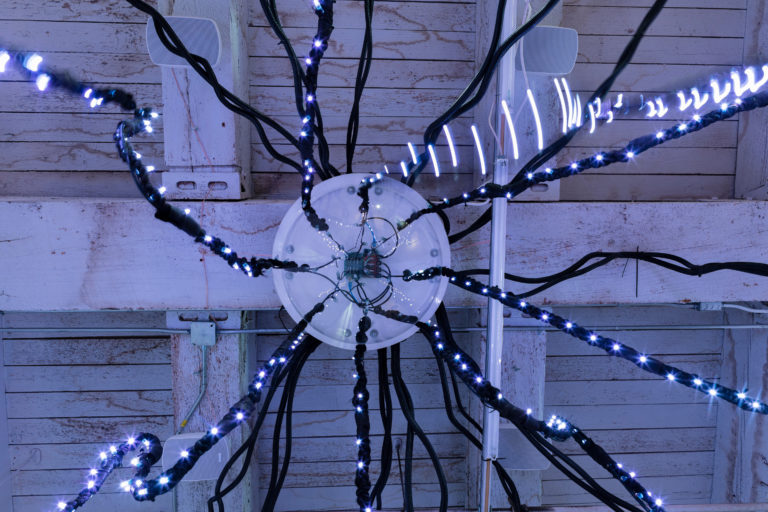 Kite and Devin Ronneberg, Ínyan Iyé (Telling Rock), 2019. Immersive installation with song, power, sound, processors, machine-learning decisions, handmade circuitry, gold, silver, copper, aluminum, silicon and fibreglass, dimensions variable. Photo: Colin Conces. © Bemis Center for Contemporary Arts, Omaha.
Kite and Devin Ronneberg, Ínyan Iyé (Telling Rock), 2019. Immersive installation with song, power, sound, processors, machine-learning decisions, handmade circuitry, gold, silver, copper, aluminum, silicon and fibreglass, dimensions variable. Photo: Colin Conces. © Bemis Center for Contemporary Arts, Omaha.
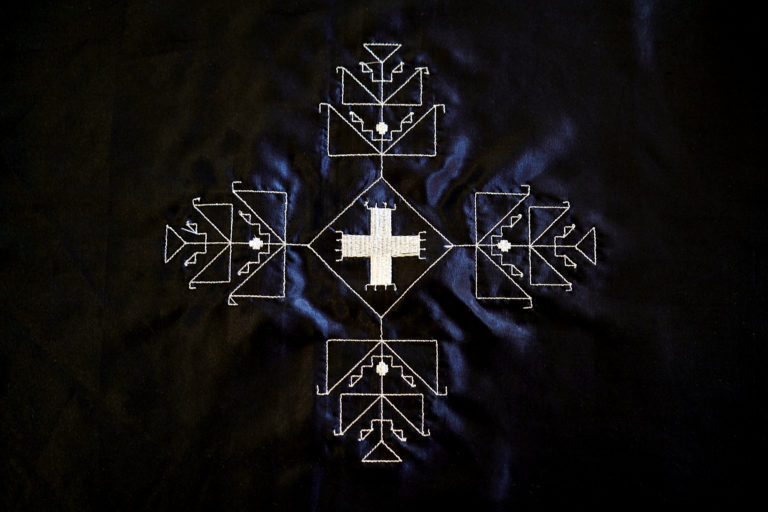 Kite, Wichahpih’a (a clear night with a star-filled sky or a starlit night) (detail), 2020. Silver thread on blue satin, 60.9 x 60.9 cm.
Kite, Wichahpih’a (a clear night with a star-filled sky or a starlit night) (detail), 2020. Silver thread on blue satin, 60.9 x 60.9 cm.
RB: The meaning of the pattern is in the process.
K: Yes, and the meaning is infinite, even if this piece itself has an end point. You could technically keep going in all directions forever, which is what I tried to animate in Listener. I hope to work on something soon where I hook up the conductive threads to circuits, and then the power can flow, potentially infinitely. The enigma of electronic power is that it emerges from a physical resource and has to be transformed in order to be perceived. When Nathan Young and I created the performance Something is Coming (2018), we were trying to sonify a natural resource—water—which is transformed into power. We created a process that takes water and transforms it into audible electronic noise. And that itself is what’s sacred: the ability to transform. This knowledge is what keeps me grounded whenever I am trying to understand or live through difficulty, like death, illness and grief. It isn’t good or bad or neutral; it’s the quality, the ability and the potential to transform. But what does that mean? Where is the source of power? Is it the audible and transmissible song or the river that has been dammed to power the speakers? Are song and source reconcilable?
RB: And we aren’t really going for reconciliation. This is about the ever- openness that we dance into.
K: Yes, that’s the mystery. There is a river that runs through the light cone, and it touches everything.

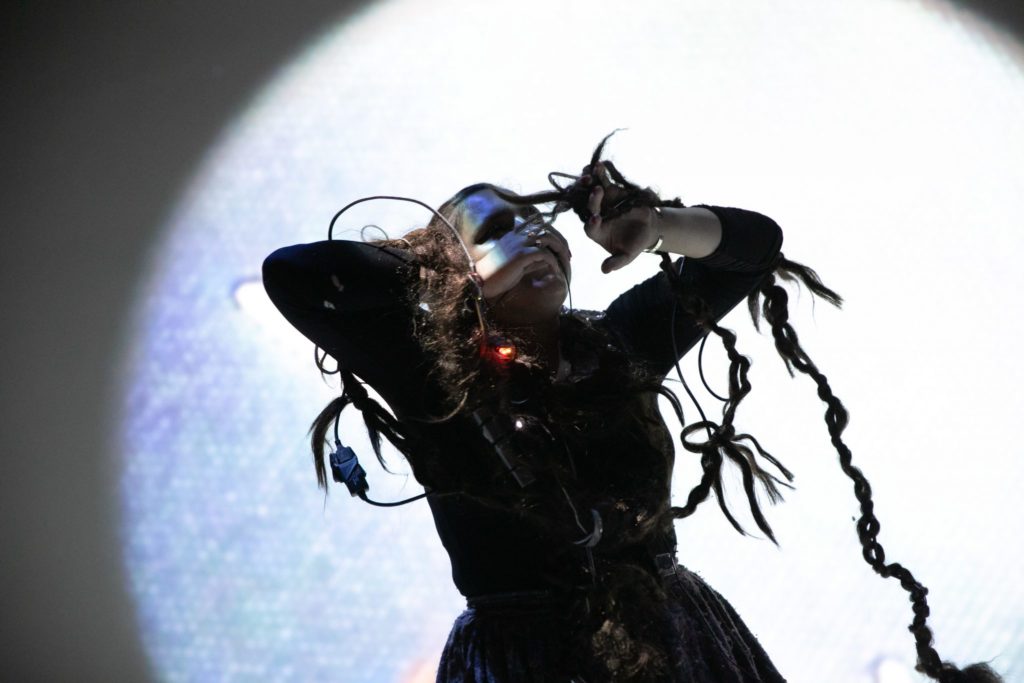 Kite, Listener, 2018. Performance in Linz, Austria. Photo: vog.photo.
Kite, Listener, 2018. Performance in Linz, Austria. Photo: vog.photo.
